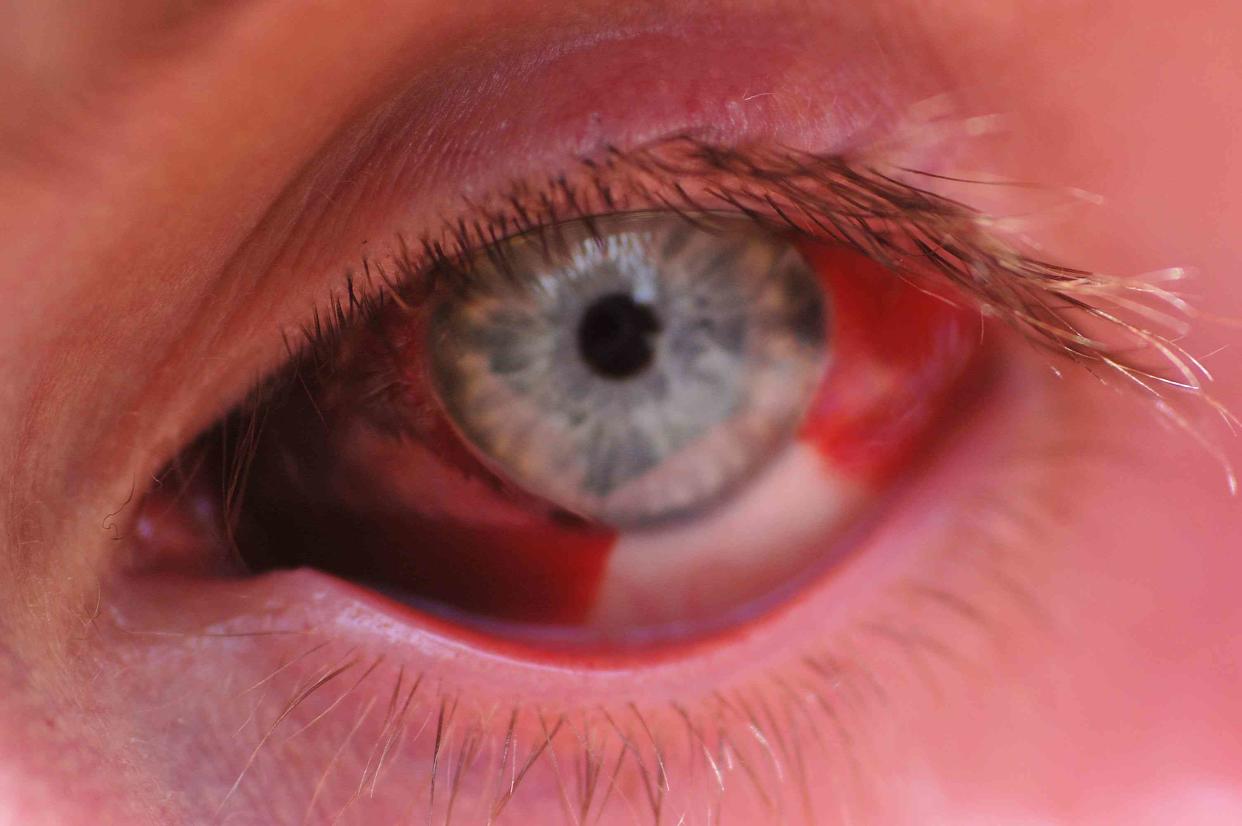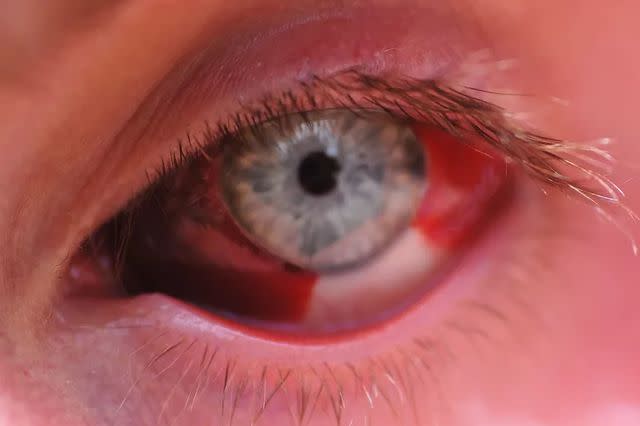Is Crying Blood Serious?

Medically reviewed by Bryan M. Wolynski, OD
Haemolacria, or crying blood, is a rare condition that is not usually a cause for concern. However, it can sometimes indicate a more serious underlying condition, so bloody tears should always be evaluated by a healthcare provider.
Blood in tears can occur with eye injuries or nosebleeds. Other causes include medications, blood disorders, uncontrolled high blood pressure, hormonal changes, or tumors.
This article will explain how blood in the tears can occur, the possible causes, and how it may be treated.

Wikimedia Commons
How Are Tears Produced?
The tear-producing nasolacrimal system is composed of several parts. The lacrimal gland is a large gland located under the eyelid that secretes tears onto the surface of the eye. Its function is to deliver tears to the eye's surface. There are also tiny glands embedded in the eyelid that produce tears.
Each eyelid typically has one punctum, or opening of a tear duct, situated along its margin in the region of its nasal area. These puncta are small holes that are easily seen on the surface of the eyelid margin. Each punctum has a small tube, or canaliculus, that leads to the nasolacrimal sac. The nasolacrimal sac and its duct open into the nose.
The tears themselves supply a lubrication function to the eye, as well as help the eye to create an optically clear image. The tears also carry nutrients, electrolytes, natural antibiotics, and oxygen to the surface of the eye and the cornea—the clear, dome-like structure on the front part of the eye.
Causes of Crying Blood
The majority of tears that contain blood are caused by the following conditions:
Eye Injuries
The conjunctiva is a clear tissue membrane that lies on top of the white part of the eye (sclera). Within the conjunctiva is a meshwork of blood vessels. Sometimes infection, inflammation, or conjunctival injuries can cause bleeding of the conjunctiva, since it is so blood-vessel rich. The blood simply seeps out and mixes with the tears, making it appear as if the person is making tears with blood in them.
Nosebleeds
A bloody nose is technically called epistaxis. The lacrimal system that produces and drains human tears is connected to the nasal cavity. As you blink, your eyelids exert a slight diagonal push toward the corner of the eye, where the puncta are located. The puncta are small holes in which the tears drain. The puncta drain into the lacrimal sac and then onto the lacrimal canal and into the nose. This is why your nose gets congested when you cry.
If you have a nosebleed and blow or pinch your nose, a reverse flow of blood can be pushed back up through the nasolacrimal system. This will cause blood to regurgitate back through the puncta and into the tears, making it appear that the tears are composed of blood.
Medications
Conditions that require taking blood thinners can also cause people to have bloody tears. This may include aspirin or heparin.
Blood Disorders
Blood disorders, including hemophilia, can cause excessive bleeding due to clotting problems. People suffering from hemophilia may bruise or bleed easily. This can show up in the eyes as bloody tears.
Patients who have frequent bruising or bleeding should be evaluated by their internist or primary care physician.
Benign Tumors
A pyogenic granuloma is a benign (non-cancerous) tumor that may grow on the conjunctiva or in the lacrimal sac. The lacrimal sac is the common junction where the two tear drainage canals join together to drain the tears.
A pyogenic granuloma can occur from an injury, bug bite, or inflammation. Pyogenic granulomas also occur commonly during pregnancy due to hormone changes in the body.
Cancer
Melanoma, the most serious form of skin cancer, can occur anywhere on the body, including the lacrimal sac, lacrimal gland, and the conjunctiva. People suffering from melanoma in these areas can have bloody tears.
Other cancers of the lacrimal sac, lacrimal gland, or the conjunctiva can also produce bloody tears. These are very serious conditions that require prompt treatment.
Uncontrolled High Blood Pressure
Although rare, bloody tears have been documented in cases of untreated high blood pressure. In most cases, what occurs is a broken blood vessel in the conjunctiva or in the nasal tissue. Because blood pressure is high, bleeding can be excessive. However, once the high blood pressure is brought down with medication, the bloody tears will stop.
Hormonal Changes
Studies have documented haemolacria during menstruation, or periods. The bleeding is most likely caused by hormonal changes. Usually, the blood in tears is found in small amounts.
Idiopathic Cause
There have been several cases of someone who cries tears of blood with no explanation and no medical cause. In these cases, no serious disease or disorders have been found, and the condition appears to resolve with time. No scientific explanation has been discovered for this rare phenomenon.
Hemolacria Diagnosis
If you're crying blood, a healthcare provider will ask you about your personal and family medical history, medications, and any recent eye injuries or other bleeding.
They will thoroughly examine your eye and may do some imaging or other tests to help identify the cause. Diagnostic tests may include:
Sinuses CT scan to provide images
Nasal endoscopy, a procedure to closely view the nasal cavity
Punctal plugs, which are tiny devices temporarily placed in the tear ducts
Eye culture, or sample, often taken with a sterile swab to be examined in a lab for abnormalities
You may be referred to an ophthalmologist, a physician who specializes in eye and vision care.
Treatment
The treatment for bloody tears will depend on the underlying cause. For example, medications may be prescribed for high blood pressure or radiation may be recommended for eye melanoma.
In some cases, haemolacria may only require some monitoring until it clears on its own.
Your healthcare provider may also flush your eye and prescribe medications, such as antibiotics to help prevent infection.
Summary
Blood in tears, medically known as haemolacria, is a rare condition. Although usually benign, you should see an eye doctor for an evaluation if you notice blood mixed with your tears. Most cases of bloody tears usually resolve as fast as they start, but in some cases, serious causes, such as uncontrolled hypertension, melanoma, or injury are to blame.

